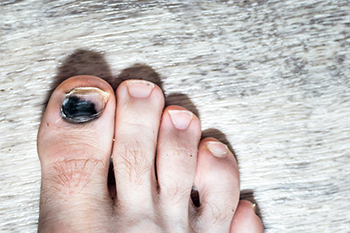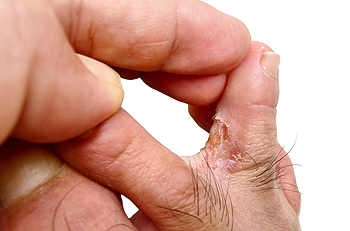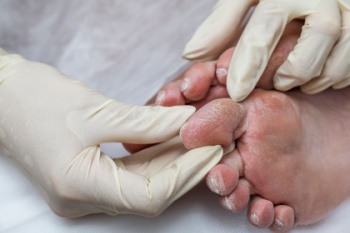3885 S. Decatur Blvd Suite #1080
Las Vegas, NV 89103

Toenail discoloration can indicate a range of issues, from minor injuries to infections or more serious conditions. A black toenail often results from trauma, such as stubbing a toe or wearing tight shoes, which causes blood to pool beneath the nail. However, if there is no known injury, a podiatrist can assess whether the discolored toenail may be due to a fungal infection, a chronic ingrown toenail, or a more concerning condition like melanoma. Yellow toenails frequently result from fungal infections, which may lead to thickened, brittle nails. A green toenail often signals a bacterial infection, generally linked to prolonged exposure to moisture. White spots or streaks on toenails may develop from repetitive pressure on the toes, while an entirely white nail could indicate a spreading fungal infection. Brown streaks may occur due to injury but should be evaluated for potential serious causes. If you have toenails that have changed color, it is suggested that you schedule an appointment with a podiatrist for an exam and treatment options.
Toe pain can disrupt your daily activities. If you have any concerns, contact Loren Hansen, DPM of Ankle & Foot Medical Center. Our doctor can provide the care you need to keep you pain-free and on your feet.
What Causes Toe Pain?
Most severe toe pain is caused due to a sports injury, trauma from dropping something heavy on the toe, or bumping into something rigid. Other problems can develop over time for various reasons.
Toe pain can be caused by one or more ailments. The most common include:
When to See a Podiatrist
Diagnosis
In many cases the cause of toe pain is obvious, but in others, a podiatrist may want to use more advanced methods to determine the problem. These can range from simple visual inspections and sensation tests to X-rays and MRI scans. Prior medical history, family medical history, and any recent physical traumatic events will all be taken into consideration for a proper diagnosis.
Treatment
Treatments for toe pain and injuries vary and may include shoe inserts, padding, taping, medicines, injections, and in some cases, surgery. If you believe that you have broken a toe, please see a podiatrist as soon as possible.
If you have any questions please feel free to contact our office located in Las Vegas, NV . We offer the newest diagnostic tools and technology to treat your foot and ankle needs.

It starts as a mild itch, just a little irritation between your toes. Maybe your skin feels dry or slightly cracked. Then, before you know it, that subtle annoyance turns into relentless burning, peeling, and redness. Athlete’s foot is not just a minor inconvenience. It is a fungal invasion thriving in warm, damp spaces like sweaty socks and shared locker rooms. Many people dismiss it, thinking it is just dry skin, but, left untreated, it spreads. Blisters can form, skin can crack open, and secondary infections can take hold. Some even find the fungus creeping into their toenails, making them thick and discolored. Scratching only makes it worse, spreading the infection to hands and other areas. Mild treatments may help, but if it keeps coming back or worsens, it is suggested that you schedule an appointment with a podiatrist who can provide stronger solutions to stop the cycle and restore healthy skin.
Athlete’s foot is an inconvenient condition that can be easily reduced with the proper treatment. If you have any concerns about your feet and ankles, contact Loren Hansen, DPM from Ankle & Foot Medical Center. Our doctor will treat your foot and ankle needs.
Athlete’s Foot: The Sole Story
Athlete's foot, also known as tinea pedis, can be an extremely contagious foot infection. It is commonly contracted in public changing areas and bathrooms, dormitory style living quarters, around locker rooms and public swimming pools, or anywhere your feet often come into contact with other people.
Solutions to Combat Athlete’s Foot
Athlete’s foot can cause many irritating symptoms such as dry and flaking skin, itching, and redness. Some more severe symptoms can include bleeding and cracked skin, intense itching and burning, and even pain when walking. In the worst cases, Athlete’s foot can cause blistering as well. Speak to your podiatrist for a better understanding of the different causes of Athlete’s foot, as well as help in determining which treatment options are best for you.
If you have any questions please feel free to contact our office located in Las Vegas, NV . We offer the newest diagnostic and treatment technologies for all your foot and ankle needs.

Your feet might know you have diabetes before you do. Changes in sensation, skin texture, and healing can be early signs of nerve and circulation issues. Many people focus on blood sugar numbers, but overlook their feet. That is, until a problem appears. Diabetes can dull the ability to feel pain, so a small cut or blister can go unnoticed and worsen. Skin may become dry and cracked as nerves struggle to regulate moisture, making infections more likely. Poor circulation slows healing, turning minor wounds into major concerns. Even the shape of your feet can shift over time due to muscle imbalances. Ignoring your feet can lead to serious complications, but daily checks, wearing proper footwear, and regular podiatry visits keep them healthy. If you have diabetes, it is suggested that you include a podiatrist on your health care team.
Diabetic foot care is important in preventing foot ailments such as ulcers. If you are suffering from diabetes or have any other concerns about your feet, contact Loren Hansen, DPM from Ankle & Foot Medical Center. Our doctor can provide the care you need to keep you pain-free and on your feet.
Diabetic Foot Care
Diabetes affects millions of people every year. The condition can damage blood vessels in many parts of the body, especially the feet. Because of this, taking care of your feet is essential if you have diabetes, and having a podiatrist help monitor your foot health is highly recommended.
The Importance of Caring for Your Feet
Patients with diabetes should have their doctor monitor their blood levels, as blood sugar levels play such a huge role in diabetic care. Monitoring these levels on a regular basis is highly advised.
It is always best to inform your healthcare professional of any concerns you may have regarding your feet, especially for diabetic patients. Early treatment and routine foot examinations are keys to maintaining proper health, especially because severe complications can arise if proper treatment is not applied.
If you have any questions please feel free to contact our office located in Las Vegas, NV . We offer the newest diagnostic and treatment technologies for all your foot and ankle needs.

Toe stretches are a simple and effective way to improve flexibility, reduce tension, and alleviate foot discomfort. One common stretch involves sitting down and using the hands to gently pull the toes backward, stretching the muscles on the top of the foot. Another effective stretch is the toe curl, where you use a towel or small object to curl your toes and squeeze for a few seconds before releasing. The seated toe stretch involves placing one foot over the opposite knee and pulling the toes toward the shin. These stretches help improve the range of motion, promote circulation, and relieve foot pain caused by conditions like plantar fasciitis or arthritis. Regularly performing these stretches can enhance foot health and overall mobility. If you have toe pain, it is suggested that you consult a podiatrist who can diagnose and treat toe conditions, and guide you on additional toe and foot stretches.
Why Stretching Is Important for Your Feet
Stretching the feet is a great way to prevent injuries. If you have any concerns with your feet consult with Loren Hansen, DPM from Ankle & Foot Medical Center. Our doctor will assess your condition and provide you with quality foot and ankle treatment.
Stretching the Feet
Stretching the muscles in the foot is an important part in any physical activity. Feet that are tight can lead to less flexibility and make you more prone to injury. One of the most common forms of foot pain, plantar fasciitis, can be stretched out to help ease the pain. Stretching can not only ease pain from plantar fasciitis but also prevent it as well. However, it is important to see a podiatrist first to determine if stretching is right for you. Podiatrists can also recommend other ways to stretch your feet. Once you know whether stretching is right for you, here are some excellent stretches you can do.
It is best to go easy when first stretching your foot and work your way up. If your foot starts hurting, stop exercising to ice and rest the foot. It is advised that you then see a podiatrist for help.
If you have any questions, please feel free to contact our office located in Las Vegas, NV . We offer the newest diagnostic and treatment technologies for all your foot care needs.